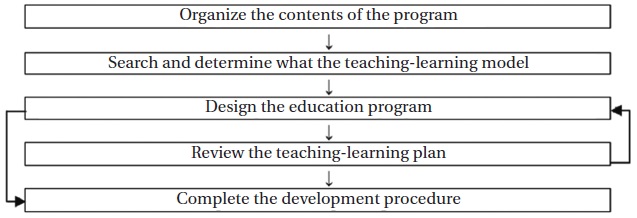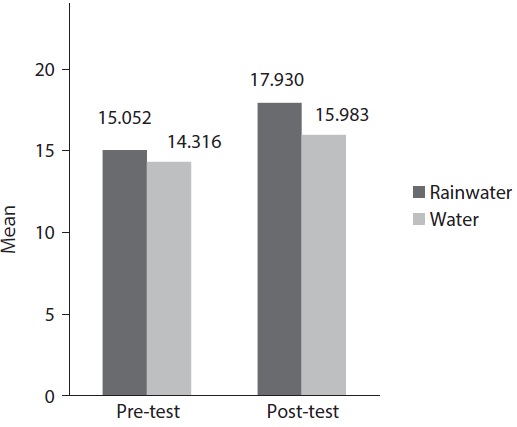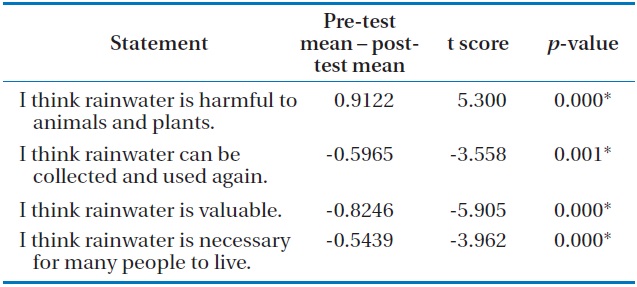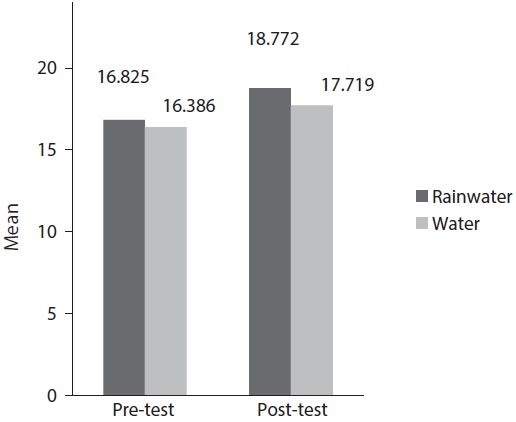



Rainwater harvesting is being applied increasingly to commercial applications in schools, housing or water demanding industries, with a growing recognition of its necessity in terms of sustainable usages of water resources [1]. Despite such new approaches to issues of rainwater, still, more or less biased perspectives have been pervasive in public as well as academic fields, tending to identify rainwater as simply a harmful pollutant derived from acid rain [2-4].
These kinds of social prejudices towards rainwater could be traced as a result of existing educational practices which have tended to only focus on the hazards of rainwater, in terms of environmental pollution problems, such as the matter of acid rain. In the case of South Korea which has an independent school subject of environmental education―has its independent field of a curriculum subject of the secondary school in South Korea, as a cultural/optional course or a discretionary activity. Since 7th educational curriculum revision, the title of the subject has been changed, from ‘The Ecology and Environment’ in the 7th version to ‘The Environment’ in the 2007 revised version, finally to ‘The Environment and Green Growth’ in the 2009 revised version, most of the subjects’ curriculum or textbooks dominantly show the distorted views about rainwater.
In the 7th revised version of the South Korean high school curriculum for the subject [5], for instance, the content regarding rainwater is merely included in the part of ‘acid rain’ as a sub-chapter of ‘The Global Environmental Problem’. Despite the omission of the sub-chapter, the 2007 revised version [6] still requires to deal with the cause and damage of acid rain under the chapter of ‘Local Environments and Global Environment’. The 2009 revised curriculum [7] of ‘Environment and Green Growth’ also includes certain learning activities focusing on the negative effect of acid rain and its prevention.
These analyses infer that most of the domestic educational practices in school deal with the issue of rainwater only in the discourse of acid rain as one of the major environmental topics. Such a skewed tendency could be subjected to criticism, as a principal offender to lead and spread out social misconceptions about rainwater. Indeed, Jenson and Schnack [8] claimed that traditional teaching methods which tend to greatly aggravate the dangers of environmental phenomena are to be avoided, for they can discourage the learner to act or participate in coping with related problems.
In spite of the negative stances of rainwater predominated in South Korea, some remarkable changes have emerged in the environmental education field to include eco-friendly aspects of rainwater. For example, the revised 8th grade language textbooks [9] entail the contents of “rainwater to save the planet” with descriptions of an efficient way of harvesting rainwater as a “great natural resource”. Besides, some schools are already equipped with rainwater facilities for alternative water supplies or for entertainment, such as eco-ponds (some schools teach environmental education through the eco-ponds with rainwater and on a regular basis to collect rainwater and hold school competitions on a regular basis to collect rainwater and poster exhibitions, which take advantages of their educational effectiveness as a substantial field of learning to help students experience the importance of rainwater [10]. In fact, according to Ministry of Environment [11], rainwater management at present is offered in 57 locations nationwide in the Korean education systems).
At this juncture, there have been little but recently increasing academic discussions about the educational necessity to promote public interests and participation in rain harvesting [12-15]. Such innovative educational trials might be reflected on notable reappraisals in policies or social movements towards rainwater with evidentiary disapproval regarding the risks of rainwater, increasingly suggested by related scientific communities [16,17]. Considering recent scientific re-evaluations as well as the lack of social awareness, rainwater education is of great significance to cultivate desired values of rainwater and to lead more related practices in public as well as policies or researching.
However, there has been little done regarding structured and practical educational efforts to encourage learners to reassess their values on rainwater in daily life as well as society, based on balanced scientific information. Thus, this study was intended to develop a school educational program for helping students learn various views on rainwater and to verify the effectiveness of the program on promoting students’ awareness and attitude towards rainwater. Through this research, it is anticipated that such an educational effort might contribute to sharing the worthiness of preserving rainwater with the future generation and promoting rainwater harvesting within wider public participation.
The objective of this research is to establish a rainwater educational program designed for improving students’ balanced attitudes and awareness towards rainwater through self-value judgement of it with relation to their daily life as well as societal issues.
2.2. Procedure for Program Development
The program was developed through five preparatory stages (Fig. 1). First, its contents are organized through documentary reviews on the secondary education curriculum of Korea and other academic researches on educational programs, regarding water as well as rainwater. Based on the literature studies, a teaching-learning plan was developed, with consideration for both the organized contents and the preliminary level of knowledge for high school students.
For the purpose of making changes in biased values of rainwater pervasive in educational practices, a value-analysis model was used as a basic frame in designing the overall program for this study. The value-analysis was originated by members of the National Council for the Social Studies (e.g., L. E. Metcalf, G. Casper, J. Coombs, and M. Meux) from 1970s. The model has
been utilized as one of the teaching-learning strategies, mainly in moral education [18], with intention to instruct students to make their own judgement, based on scientific facts as well as their subjectivity [19]. This type of value analysis can be applicable to fields required to stress objectivity through analytical decisions, for instance, in dealing with conflicts surrounding environmental issues [20-22].
Given this applicability of the value analysis model, the rainwater education program was established, but with some revision in details from original frames according to the objectives of this study. Its development was reviewed by three experts in the field of environmental education and completed after additional inner review and modification.
2.3. Details of the Rainwater Education Program
The rainwater educational program consisted of two parts divided according to two major constituents of the value-analysis mode, required to make a judgment about certain objects [19]; a set of facts and a value principle. Based on the first mode, the former part of the program was designed in three steps to make students commit themselves to clarifying the issues, investigating the scientific facts and making a tentative judgment. The latter part, for the second mode of the value principle, was made up of two steps: examining the value principles and making a final decision. A rough form of the teaching-learning strategy is shown in Table 1.
2.3.1. Identifying and clarifying the question
Identifying and clarifying issues is the very first step to approach the problems which are subject to value judgments. At this stage, it is necessary to define the concept of objects of the judgment for avoiding linguistic confusions. In the class, before the beginning, a brief pre-activity was conducted to call students’ attention by questioning how they feel when listening to sounds of raindrops. Following the intro, the students were lead to make sense of their pre-understandings of the key object, rainwater, by filling an empty box with their answers of what the rainwater refers to for them.
After checking their existing thoughts of rainwater, to make students identify conflicts of different values surrounding the issue of rainwater, some TV news reports were watched, which show two contrasting perspectives towards rainwater. Specifically, one dealt with the risks of acid rain in urban buildings and the other mentioned rain harvesting as an alternative way to secure water with some examples in Korea.
To clarify the context of each report, students were requested to summarize the main points and take a pop-up quiz about the details of the news on a worksheet. The pupils were also asked to make a short presentation of their summary and answers to share them with others. Additionally, an interrogatory method of teaching was executed to help students discover the logical interrelationships between the two viewpoints by comparing the information offered in the news reports.
2.3.2. Assessing the truth of purported facts and clarifying their relevance
Based on the preliminary step to clarify the issues, the next step of assessing facts allowed students to explore evidences for making their judgments towards the problematic objects through observations, documents, or explanations by experts. To help students obtain balanced information on rainwater, a simple in-class experiment was conducted for the purpose of disproving the harmfulness of rainwater based on the empirical evidence. The experiment was designed to compare acidities between rainwater and other acidic liquids such as grape juice, orange and coke by using pH testing papers. As a student-centered activity, students were encouraged to perform the test by themselves under basic guidance from a teacher. After the pH testing, students noted and shared the results by comparison between the value of rainwater and that of other materials.
[Table 1.] Teaching-learning strategies of the program
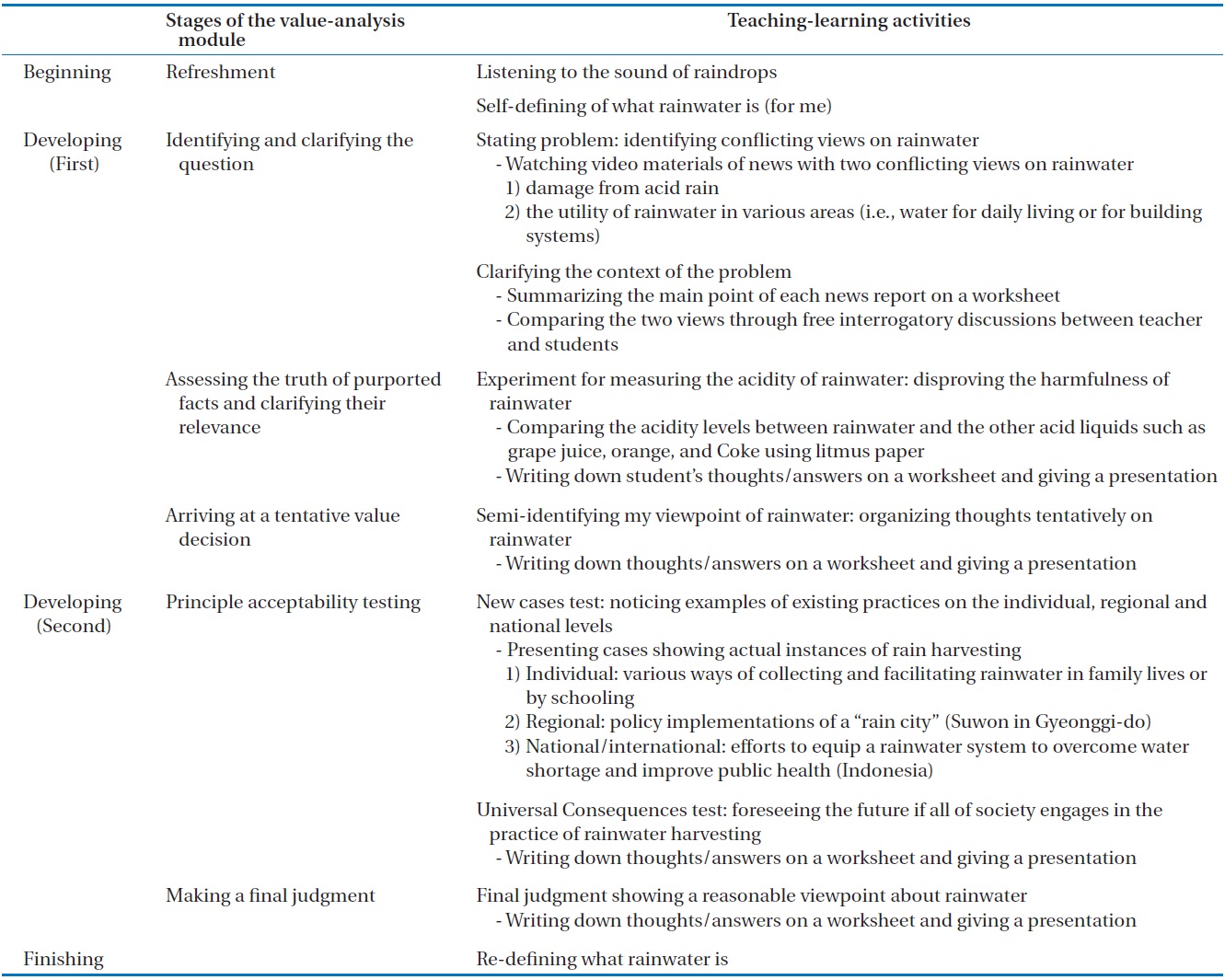
Teaching-learning strategies of the program
2.3.3. Arriving at a tentative value decision
This stage is the final constituent of the first part in the program, where students look back on their activities and come to their own values on the issue, as a semi-judgment. In the lesson, students were required to make provisional decisions regarding the value of rainwater, which they wrote on their worksheets and presented to others. They were asked to consider what they were thinking during the activities of watching videos and testing the pH values of rainwater.
2.3.4. Principle acceptability testing
Values judgments should include the principle of values which takes a fundamental role as a mechanism for decision making, and should be able to consider scientific facts. At this stage, students participated in some activities in order to reflect on existing principles in their own way of thinking and make sure whether they could accept the new value principles to view the issues. In this study, among various ways of verifying the principle of values, two methods of the new case test and universal consequence test were implemented.
The former of the new case test let students reexamine a certain issue differently from existing perspectives through specific cases as counter-evidences. In the course, some visual images were presented to make students figure out recently-compelling perspectives of rainwater as an alternative natural water pull, beyond the existing tendency to abandon it as a harmful waste. The pictures included scenes which illustrate practical ways of rain harvesting at the individual, regional and national levels. Through short lecturing of the instructor, some explanations were offered, with emphasis on the contributions of rain harvesting to coping with social problems, like poverty or just distribution of water, as well as its expected economic profitability.
As a final activity of this step, a revised form of the universal consequences test was conducted, the test which encourages students to foresee a future when such alternative perspectives or practices are in common. For the test, students were asked to imagine and discuss how the future world looks like if all of the communities come to put themselves in rainwater harvesting as an alternative water system.
2.3.5. Making a final judgment
The last stage was to make a final value judgment based on both the activities of exploring the scientific evidence and testing the principles of values. To help students organize their thoughts, these key questions were offered. These included the following:
1) Are you interested in rain harvesting at home?
2) What would you say if a regional rain harvesting system were established in your community?
3) What would you say if this practice becomes more common? Finally, the students were asked to write down what they think during the activity as part of their rainwater education program and to share their ideas through a freestyle presentation.
2.4.1. Population
The program was applied to 57 students in their first year of high school, from two science classes in Namyangju-si, Gyeonggi- do, Korea. The demographic characteristics of the students are shown in Table 2. The subjects were considered almost equal in terms of the ratio of gender and moderate levels of environmental interest. Among the students, 96.5% have no experiences
[Table 2.] Demographic background of the subjects (n=57)
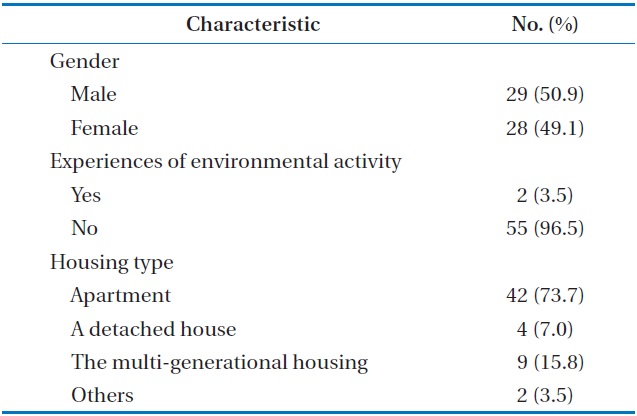
Demographic background of the subjects (n=57)
of environmental-related activity and 73.7% of students lived in apartments, followed by multi-generational households and single-home houses.
2.4.2. Application of the program
The program was run during 2 hr per a day in a science class, over 2 days on February 8?9, 2012. The class in the first day covered the former part of the program, related to the exploration of a set of scientific facts. The latter part regarding exploration of value principles was dealt with in the second day. Before the program, students were informed that an outside teacher would be invited to offer them a special lecture in their science class. Nevertheless, the pupils did not know the intention or context of this research during the program.
2.4.3. Inspection tool
The purpose of this study is to foster students’ balanced values of rainwater through a rainwater education program based on a value-analysis model. In this sense, the values can be described as a frame within which available information about the state of the environment was interpreted [23]. Within similar contexts, Stern [24] and Stern and Dietz [25] argued that people’s problem awareness are closely related to the values in that the extent of how serious people perceive environmental problems depends on individuals’ values. Meanwhile, Schultz and Zelezny [26] addressed the relationship between a set of values and attitudes which determine people’s beliefs or, further actions regarding environmental concerns. Thus, refreshing personal values can result in certain educational effects as fostering peoples’ pro-environmental awareness as well as attitudes.
Based on the literature reviews, this study attempts to verify the effectiveness of the program on improving students’ awareness and attitudes on rainwater. For the purpose, surveys were conducted with students twice by using a one-group pre- and post-test in the administration of identical questionnaires. The pre/post testing is useful to find out significant effectiveness differences between before and after the application of the program [27].
The questionnaire was developed on the basis of the description of consciousness and attitudes of environmental education goals regarding the United Nations Educational, Scientific and Cultural Organization (UNESCO) [28]. A draft questionnaire was made in reference to questioning items related to the issues of rainwater, developed by Kwon [12] and another by So et al. [29]. Additionally, this research anticipated that the rainwater educational program might also influence students’ awareness and attitudes about water, which is one of the major environmental themes closely related to the issue of rainwater. Hence, the questionnaire also included the items related to water in the same form of sentences as those of the rainwater-related part. The final form was completed after reviewing and modifying the draft with the consultation of experts of the environment education.
2.4.3.1. Awareness inventory
According to UNESCO, environmental education for students’ awareness should aim to foster their recognition and sensitivity of environment and of related issues that affect individuals and society. Following the statement, in this research, awareness about rainwater was defined as recognition and sensitivity of the water environment and of relevant environmental issues students face in their individual or social life. Based on this definition, eight inquiries were created to measure the awareness of preconstudents, in total comprising four questions about rainwater and four items about water. The reliability of the rainwater-related recognition items showed a Cronbach’s α reliability coefficient of 0.707, and the coefficient for the water-related recognition items was 0.714. These figures mean the measurements are reliable to be generalized in other researches expecting similar results if the same instrument is utilized, because of their higher numerical values over 0.5?0.6 of Cronbach’s alpha, standardized by Peterson [30].
2.4.3.2. Attitude inventory
According to UNESCO, environmental education for students’ attitude should aim to foster their values and interests about the environment and to instil a motive for active participation in environmental protection and improvement of individuals or society as a whole. In this study, attitude about rainwater was defined in terms of values and interests pertaining to the issues of rainwater and motivations for active participation in conservation and harvesting of rainwater in their daily or social life. Based on this definition, ten inquiries were created to measure the attitude of students, in total comprising five questions about rainwater and five items about water. The reliability of the rainwater-related attitude had a Cronbach’s alpha reliability coefficient of 0.699, and the reliability for the water-related attitude was 0.676. These figures mean the measurements are reliable to be generalized in other researches expecting similar results if the same instrument is utilized, because of their higher numerical values over 0.5?0.6 of Cronbach’s alpha, standardized by Peterson [30].
2.4.4. Data analysis
Changes in students’ awareness and attitude were evaluated using PASW (SPSS) Statistics ver. 18.0 (SPSS Inc., Chicago, IL, USA). Each question was rated on a Likert-type scale. The five possible responses to a positive statement were 1 (strongly disagree), 2 (disagree), 3 (neither), 4 (agree), and 5 (strongly agree). Negative statements were given the opposite coding. Paired sample t-tests were used to test for statistical significance between pre- and post-tests.
Students’ environmental awareness was more positive for rainwater and water after exposure to the education program (Fig. 2). The increase was statistically significant according to a paired t-test comparison of pre- and post-test mean results (Table 3). The “pre-test mean ? post-test mean” refers to the differences between pre-test mean and post-test mean about rainwater awareness statements. To determine if the means differed among statements, paired samples t-tests were used to compare individual pre- and post-test awareness statements.
It was also found that students who received the education program possessed more positive awareness for water as well as rainwater. This indicated that the program made the students aware of water as a broader area as compared to merely rainwater alone.
Of the four awareness statements for rainwater, all the statements showed statistically significant higher mean values on the post-test compared to the pre-test mean scores (Table 4). The significant statements were as follows: ‘I think rainwater is harmful to animals and plants’ (t = 5.300,
In particular, the statement ‘harmful to animals and plants’ showed lower results. This indicates that the program made the students aware of rainwater as a resource for all living things. The statements ‘collected and used again’, ‘valuable’, and ‘necessary’ for rainwater demonstrated higher results. This indicates that the education program allowed students to shed their preconceptions

Comparison of high school students’ environmental levels of awareness as indicated from a paired samples t-test

Rainwater awareness statements, awareness test means, and statistically significant changes acquired from the paired samples t-test (n = 57)
and sense new value in rainwater.
Of the four attitude statements for water, two statements had statistically significant higher mean scores on the post-test compared with the pre-test mean scores (Table 5). The significant statements were ‘I think I pollute the water at school’ and ‘I think it is necessary for people to live’. Through the program, the students reflected on water pollution and improved their awareness of the importance and necessity of water.
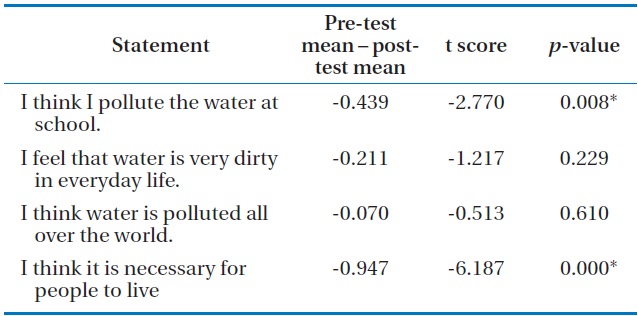
Water awareness statements, awareness test means, and statistical significant acquired from the paired samples t-test (n = 57)

Comparison of high school students’ environmental attitudes as indicated from a paired samples t-test
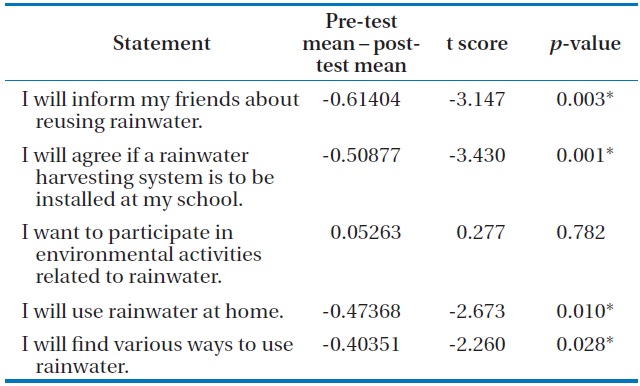
Rainwater attitude statements, attitude test means, and statistical significant acquired from the paired samples t-test (n = 57)
Students’ environmental attitudes were more positive for rainwater and water after exposure to the education program (Fig. 3). The increase was statistically significant according to a paired t-test comparison of the pre- and post-test mean results (Table 6).
The mean values indicated a change in attitude toward a more favourable environmental attitude. It was also found that students who received the education program possessed more positive attitudes for water as well as rainwater. This suggests that rainwater affected their attitudes toward water.
Of the five attitude statements for rainwater, four statements had statistically significant higher mean scores on the post-test compared with the pre-test mean scores (Table 7). The significant statements were ‘I will inform my friends about reusing rainwater’, ‘I will agree if a rainwater harvesting system is to be installed at my school’, ‘I will use rainwater at home’, and ‘I will find various ways to use rainwater’.
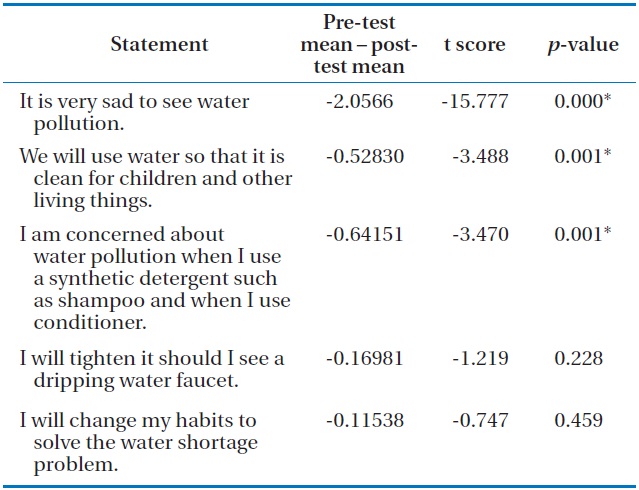
Water attitude statements, attitude test means, and statistical significant acquired from paired samples t-test (n = 57)
This showed that students had the motivation to participate in reusing rainwater actively. Specifically, the students stated that they had the will to reuse rainwater at home and at school. This suggests that the program contributed positively to the students by increasing their personal feelings of concern. However, there were no changes in terms of participation in environmental activities for rainwater. This suggests that the program did not improve their action tendencies. This may have stemmed from the program being run for a short time.
Of the five attitude statements for rainwater, three statements had statistically significantly higher mean scores on the post-test compared with the pre-test mean scores (Table 8). The significant statements were as follows: ‘It is very sad to see water pollution’, ‘We will use water so that it is clean for children and other living things’, and ‘I am concerned about water pollution when I use a synthetic detergent such as shampoo and when I use conditioner’.
The students acquired feelings of concern and the motivation to participate actively in water-related efforts. However, the statements ‘I will tighten it should I see a dripping water faucet’ and ‘I will change my habit to solve the water shortage problem’ showed no changes.
The purpose of this research is to design a rainwater education program for high school students in South Korea and investigate the effect of it on their awareness and attitude toward rainwater and water. The conclusions are drawn from this study as follows: First, the rainwater education program has a positive effect on students’ awareness of rainwater (t = -6.496,
Second, the rainwater education program also has an affirmative influence on students’ attitude towards rainwater (t = -2.877,
Based on experiential findings, the study has an implication as an attempt to develop an effective teaching-learning method for promoting more balanced awareness and attitudes about the environmental issues of rainwater as well as water. Such an educational trial might contribute to improving environmental friendly values for future generations and, further, leading to wider civic participation in sustainable usages of water resources.
Despite its commitments, however, this kind of single and short-term environmental education program has a limitation to lead or observe students’ actual practices for sustainable usages of rainwater or water in daily. Indeed, in this research, the attitude of students on both water and rainwater is relatively low at the detailed questionnaires related to action tendency, which ask them directly to engage in a sort of rain recycling or harvesting in their daily lives. Therefore, it is necessary to develop a more successive and complicated program specialized for rainwater education which could lead students to put them into practice in their ordinary lives.
